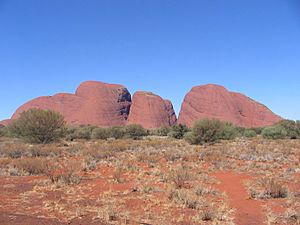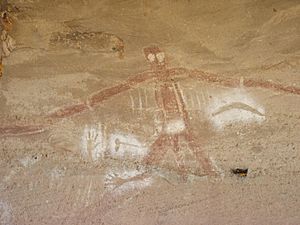Dreaming (spirituality) facts for kids


In Australian Aboriginal culture, there is a special set of beliefs called the Dreamtime or The Dreaming. It is a very deep and important part of their way of life. The Dreamtime is about four main things: how everything began, the power of the ancestors, how life and death work, and the power in life itself.
The Dreamtime is special because it includes all these things at once. It is more powerful than regular time and space. Aboriginal people call it the "all-at-once time." This is because they believe it is the past, present, and future all happening together. It is a beginning that never ends.
Aboriginal people connect with the Dreamtime through special dances and songs. They believe that everyone has a part of them that lives forever. This part existed before a person was born and will continue after they die. This eternal part exists within The Dreamtime.
Contents
What is The Dreamtime?
All Australian Aboriginal people believe in the Dreamtime. However, each group and even each person has their own unique stories and traditions. For example, in Central Australia, the Pitjantjatjara people call it the Tjukurpa.
Understanding the Tjukurpa
The Tjukurpa helps answer important questions about life. It also provides rules for how people should behave and live together. It explains the deep connection between people, animals, plants, and the land. It teaches how and why the land must be cared for.
The Tjukurpa also shares information about what foods can be eaten. It gives rules for marriage, growing up, and ceremonies for death. Some parts of the Dreamtime are only known by those who have earned the right to that knowledge.
The Creation Time
The term "Dreamtime" is often used to describe the time before time began. It is also known as the time of creation. Most Aboriginal people believe that all life is connected to the great spirit ancestors of the Dreamtime.
Every hill, water hole, river, and even the sky was created during the Dreamtime. The journeys of these ancestors across the country shaped the landscape. They also filled it with plants and animals.
Songlines and Ancestor Journeys
These journeys of the ancestors are often told through cycles of stories, songs, and dances. These are known as iwara, or songlines. The great spirit ancestors have not left; they are still present, even if they cannot be seen.
Ceremonies with songs and dances help people stay connected with these spirits. It is believed that "Without ceremony the land soon dies." This shows how important these traditions are for keeping the land alive and healthy.
Images for kids
-
Stencil art at Carnarvon Gorge. These might be memorials, signs from ancestors, or records of Dreaming stories.
-
A petroglyph (rock carving) in Ku-ring-gai Chase. It shows Baiame, the Creator God and Sky Father in the Dreaming of several Aboriginal groups.
See also
 In Spanish: Tiempo del Sueño para niños
In Spanish: Tiempo del Sueño para niños




